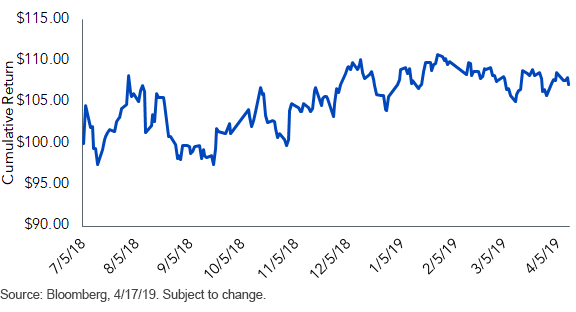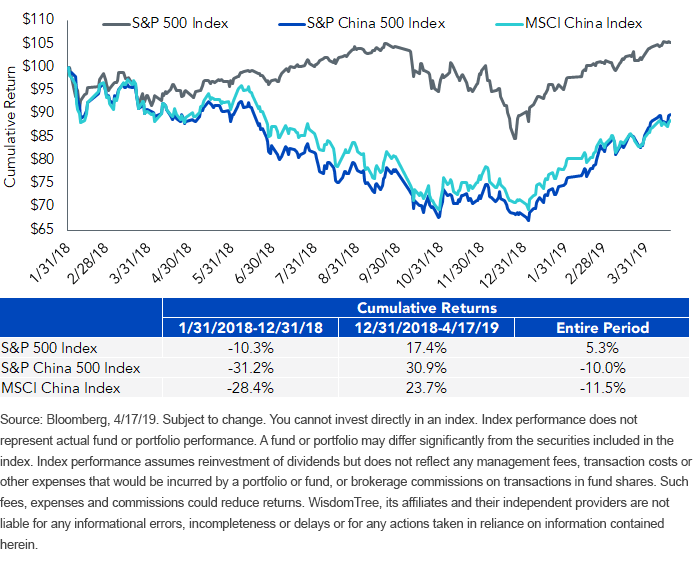How Close Are We to a U.S.–China Trade Deal?


Today marks the 298th day of the U.S.–China trade war.
The trade war has taken a toll on the American, Chinese and global economies in the past 10 months. But through our examination of both Western and Chinese media reports, we have concluded that a trade deal is likely to occur over the next month. Below, we outline the progress made and what points still need to be hashed out.
The ninth round of meetings between U.S. and Chinese trade representatives concluded April 5, 2019. China’s Department of Commerce reported that a “significant breakthrough has been made on issues such as technology transfer, intellectual property protection, tariff reduction, deficit balance, and enforcement mechanisms.”1 Treasury Secretary Steven Mnuchin also echoed that “the U.S. and China are making progress on a trade deal,” and has agreed on an enforcement mechanism, which was one of the biggest concerns for the U.S.2 Furthermore, on April 4, 2019, President Donald Trump anticipated a trade deal would be made within four weeks.3
Checking Boxes
Last May, the U.S. government released a document called “Balancing the Trade Relationship” that stated its demands from China.4 These demands focused on eight areas: tariff reduction, trade deficit reduction, intellectual property protection, U.S. investments protection, enforcement mechanisms, sensitive technology restriction, market access improvement on services and market access improvement on agricultural products.
We’ve seen a good amount of progress on each item:
- Tariff reduction: After three rounds of retaliatory tariffs, both the U.S. and China agreed to put a pause on raising tariffs on December 23, 2018. China had also made concessions on December 14, 2018, by lowering its additional 25% tariffs on U.S. autos for three months. On March 31, 2019, China extended the suspension without indicating an expiration date.
China proposed another aggressive reduction of tariffs by promising to import large amounts of American agricultural and energy products. In return, the U.S. is expected to cut $200 billion from its existing $250 billion in tariffs.5
- Trade deficit reduction: China resumed buying soybeans from the U.S. after a six-month hold that began on December 14, 2018. On January 31, 2019, China offered to buy 5 million tons of U.S. soybeans. In addition, both countries publicly stated on January 9, 2019, that they’re looking for a structural change, with the idea of a non-tariff barrier.6
Soybean Futures

- Intellectual property protection: In December 2018, as part of the ongoing negotiations, China increased its monitoring and punishment measures for Chinese entities that coerce foreign entities to forgo or transfer away their intellectual properties. The potential punishments include a ban from government funding, prohibition from importing and exporting, and limitation to obtain and use land.7
- U.S. investments protection in China: China stated it will not discriminate against foreign companies “when it sets new standards for technological equipment.” It will also not provide subsidies or employ antitrust laws to tilt the playground in favor of Chinese companies.8 And it lifted foreign ownership caps on banks last year.9
- Enforcement mechanisms: Two weeks ago, U.S. and Chinese representatives agreed there would be “enforcement offices” to deal with future trade disputes. The U.S. continues to lobby for the ability to unilaterally reimpose tariffs should China violate the agreement. In return, the Chinese have asked that tariffs from 2017 be removed. Additionally, China prefers that the WTO be used to adjudicate disputes, instead of the unilateral approach.
Taking the Next Step
The end of 2018 marked a turning point. Before December 2018, the U.S. and China traded barbs by imposing three rounds of tariffs. As a result, the U.S. market sold off by 20% from its high, while Chinese stocks declined by over 30%. Since both governments released positive statements on their progress, stocks have nearly recovered to all-time highs. However, despite strong YTD performance in China, most indexes remain 15% below levels seen before the trade war.
Performance

Interestingly, the S&P China 500 Index dominated performances in the first quarter of 2019, generating a 7% return over the MSCI China Index. According to our research, this performance can be attributed to the S&P China 500 Index’s 50% weight in China A-shares in contrast with MSCI China Index’s 2% weight.
While negotiations are far from over, we believe the bottom in Chinese equity markets is now behind us. In our view, the WisdomTree ICBCCS S&P China 500 Fund (WCHN) could be a good way to position your portfolio for a Chinese rebound.
1https://www.yicai.com/news/100159990.html
2Yun Li, “Treasury Secretary Mnuchin Says U.S. and China Have Agreed on the Trade Deal Enforcement Mechanism,” CNBC, 4/10/19. https://www.cnbc.com/2019/04/10/treasury-secretary-mnuchin-says-he-had-very-productive-trade-meeting-with-china-on-tuesday.html
3Jeff Mason and David Lauder, “Trump Says U.S.–China Trade Deal May Be Reached in Four Weeks,” Reuters, 4/4/19. https://www.reuters.com/article/us-usa-trade-china/trump-says-u-s-china-trade-deal-may-be-reached-in-four-weeks-idUSKCN1RG1OX
4Enda Curran and Keith Zhai, “Here's What the U.S., China Demanded of Each Other on Trade,” Bloomberg, 5/4/19. https://www.bloomberg.com/news/articles/2018-05-04/here-s-what-u-s-demanded-of-china-at-the-start-of-trade-talks
5https://cn.nytimes.com/business/20190304/us-china-trade-deal-trump/
6Dorcas Wong and Alexander Chipman Koty, “The U.S.–China Trade War: A Timeline,” China Briefing, 4/12/19. https://www.china-briefing.com/news/the-us-china-trade-war-a-timeline/
7Karen Yeung and Sidney Leng, “U.S.–China trade war: Can China Meet U.S. Demands on IP Theft and Forced Technology Transfer?” South China Morning Post, 2/25/19. https://www.scmp.com/economy/china-economy/article/2187312/us-china-trade-war-can-china-meet-us-demands-ip-theft-and
8Ana Swanson and Jim Tankersley, “As Trump Moves to End Trade War with China, Business Asks: Was It Worth It?” New York Times, 3/4/19. https://www.nytimes.com/2019/03/04/us/politics/trump-china-tariffs-trade-deal.html
9“China Pledged to Give Foreign Financial Firms More Access. How’s That Going?” Bloomberg, 4/2/19. https://www.bloomberg.com/news/articles/2019-04-02/how-s-china-s-opening-to-the-financial-sector-going-quicktake
Important Risks Related to this Article
There are risks associated with investing, including possible loss of principal. Foreign investing involves special risks, such as risk of loss from currency fluctuation or political or economic uncertainty. The Fund focuses its investments in China, including A-shares, which include risk of the RQFII regime and Stock Connect program, thereby increasing the impact of events and developments associated with the region which can adversely affect performance. Investments in emerging or offshore markets are generally less liquid and less efficient than investments in developed markets and are subject to additional risks, such as risks of adverse governmental regulation and intervention or political developments. The Fund’s exposure to certain sectors may increase its vulnerability to any single economic or regulatory development related to such sectors. As this Fund can have a high concentration in some issuers, the Fund can be adversely impacted by changes affecting those issuers. The Fund will be required to include cash as part of its redemption proceeds which introduces additional risks, particularly due to the potential volatility in the Chinese market and market closures. The Fund invests in the securities included in, or representative of, its Index regardless of their investment merit and the Fund does not attempt to outperform its Index or take defensive positions in declining markets. Due to the investment strategy of this Fund it may make higher capital gain distributions than other ETFs. Please read the Fund’s prospectus for specific details regarding the Fund’s risk profile.

Jianing Wu joined WisdomTree as a Research Analyst in October 2018. She is responsible for analyzing market trends and helping support WisdomTree’s research efforts. Previously, Jianing completed internships and projects at Geode Capital, Starwint Capital, and Invesco Great Wall Fund Management with a focus in quantitative research. Jianing received her M.S in Finance from the Massachusetts Institute of Technology. She graduated with honors from Boston College with degrees in Mathematics and Philosophy.

